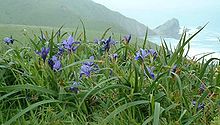- Iris douglasiana
-
Douglas Iris 
Douglas Iris, Point Reyes National Seashore Scientific classification Kingdom: Plantae (unranked): Angiosperms (unranked): Monocots Order: Asparagales Family: Iridaceae Genus: Iris Subgenus: Limniris Series: Iris ser. Californicae Species: I. douglasiana Binomial name Iris douglasiana
Herb.Iris douglasiana, known as the Douglas iris, is a common and attractive wildflower of the coastal regions of Northern and Central California and southern Oregon. The names Iris beecheyana and I. watsoniana have also been used for this plant, but Iris douglasiana has precedence.
The Douglas Iris grows mainly at lower elevations, below 100 metres (330 ft), though it is occasionally found at heights of up to 1,000 metres (3,300 ft). It is most common in grasslands near the coast; it is regarded as a noxious weed in pastures, because it forms clumps that inhibit other vegetation, and its leaves are bitter and unpalatable to cattle.
This is a typical beardless Iris of subgenus Limniris, series Californicae, growing from a rhizome that is typically under a centimetre in diameter. Its leaves are about 2 centimetres (1 in) wide. It flowers from April to June. Flowers are usually a purplish-blue, though occasionally white or yellow flowers are found. Two or three flowers are found on each stem, which is of variable height, ranging from 15–80 centimetres (5.9–31 in) tall.
Several varieties have been recognised, for example Iris douglasiana var. altissima (Jeps.) and Iris douglasiana var. oregonensis (R. C. Foster), but the species is highly variable and the varieties may not be well enough defined to be of much practical use. The Douglas Iris hybridises freely with several other species; its natural hybrid with I. innominata has been designated as Iris ×thompsonii (R. C. Foster), and the garden hybrid with the same species as Iris ×aureonympha (E. H. English).
External links
Categories:- Flowers
- Iris
- Flora of California chaparral and woodlands
- Flora of Oregon
- Garden plants
Wikimedia Foundation. 2010.

